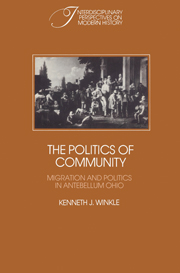Book contents
- Frontmatter
- Contents
- List of tables and figures
- Preface
- Introduction
- 1 The tide of emigration
- 2 An electorate in motion
- 3 From meeting to election: migration and suffrage
- 4 The defended community: migration and elections
- 5 “A movable column”: migration and voting
- 6 The core community: migration and leadership
- 7 Migration and local politics: an antebellum election
- Conclusion
- Notes
- Bibliography
- Index
2 - An electorate in motion
Published online by Cambridge University Press: 06 October 2009
- Frontmatter
- Contents
- List of tables and figures
- Preface
- Introduction
- 1 The tide of emigration
- 2 An electorate in motion
- 3 From meeting to election: migration and suffrage
- 4 The defended community: migration and elections
- 5 “A movable column”: migration and voting
- 6 The core community: migration and leadership
- 7 Migration and local politics: an antebellum election
- Conclusion
- Notes
- Bibliography
- Index
Summary
A popular view of nineteenth-century society maintained that farm families were much more firmly rooted than were city people and that country living was therefore less hectic and more stable than urban life. In 1855, for example, Mrs. Josephine Bateham, editor of the “Ladies' Department” of the influential agricultural journal The Ohio Cultivator, told her readers that
One of the great blessings of rural life … is, there is less frequent occasion for removals; indeed, few farmers' families as such, except for those bound for “the West,” ever make a greater change of residence than from the old log home to the new “frame.” But in the city, the moving day which comes every year or two … is the spectre that haunts a large portion of the population.
Nineteenth-century rural society, as Mrs. Bateham viewed it, was far more stable than urban life. Country dwellers, and especially farm families, tended to stay put, moving up instead of out (to the new “frame”) because upward social mobility minimized the need for emigration. Urban migrants, on the other hand, were quite different from rural migrants. In cities, “removal” occurred much more frequently, and it involved more residents. A rather sinister “moving day” shadowed the less settled city dwellers, many of whom actually moved “every year or two.”
- Type
- Chapter
- Information
- The Politics of CommunityMigration and Politics in Antebellum Ohio, pp. 30 - 47Publisher: Cambridge University PressPrint publication year: 1988



